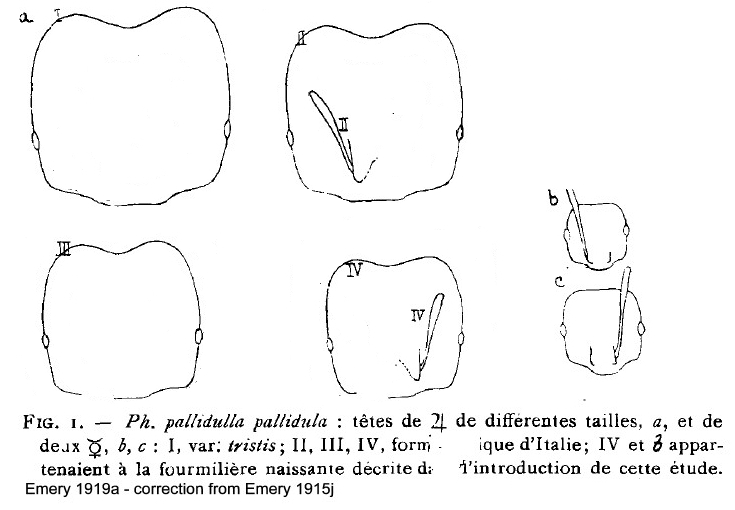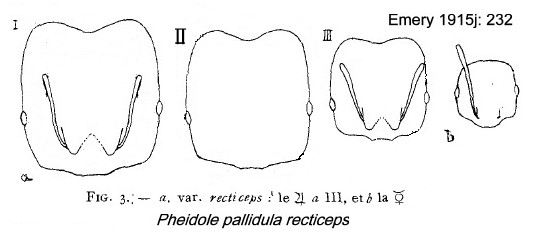Pheidole pallidula (Nylander) - revised
 Iran list Iran list
 Egypt list Egypt list  Type location Sicily
(Myrmica pallidula, Nylander, 1849: 42, worker; Oecophthora
pallidula,
Mayr, 1855: 457, major, queen & male) from Messina,
collector Cel. Zeller; no images on
Antweb (April 2017) - Radchenko (2007: 33) reported the specimens as
intact in the Finnish Museum of Natural History and "fully
correspond(ing) to the modern treatment of Pheidole pallidula". Type location Sicily
(Myrmica pallidula, Nylander, 1849: 42, worker; Oecophthora
pallidula,
Mayr, 1855: 457, major, queen & male) from Messina,
collector Cel. Zeller; no images on
Antweb (April 2017) - Radchenko (2007: 33) reported the specimens as
intact in the Finnish Museum of Natural History and "fully
correspond(ing) to the modern treatment of Pheidole pallidula".
junior synonyms
inquilina (Xenophaenogaster inquilina, Baroni
Urbani, 1964b: 50, illustrated, worker; surmised synonymy by Bolton,
1987: 291)
from Sicily - no images on
Antweb (November 2014)
megacephala (Myrmica megacephala, Losana,
1834: 328, major & minor workers) from Italy, Piedmont,
collected
by M Losana - no images on
Antweb (November 2014)
subdentata (Oecophthora subdentata,
Mayr,
1853a: 145, major & minor workers; synonymy by Mayr, 1855: 455)
from Austria, numerous collections - see below
subspecies
obscura (Pheidole pallidula v. n. emeryi,
Krausse, 1912a: 169, major & minor workers; replacement name by
Santschi, 1936c: 200) from Sardinia, Sedda de Pranu, Monti del
Gennargentu, vii.1912 - no images on
Antweb (November 2014)
Note: Former junior synonym recticeps
removed here to Pheidole
cicatricosa.
|
 Nylander's (1849) description is at Nylander's (1849) description is at  . Losana (1833) described specimens of "M.
[Myrmica] megacephala" from "our garden, referring to "the megacephala
of
Latreille"; this is at . Losana (1833) described specimens of "M.
[Myrmica] megacephala" from "our garden, referring to "the megacephala
of
Latreille"; this is at  . Mayr's (1853a)
description of subdentata is at . Mayr's (1853a)
description of subdentata is at  . Mayr's (1855) descriptions are at . Mayr's (1855) descriptions are at  and and  . Roger (1862c: 294) gave a note to clarify
the conflicting use of the name Myrmica megacephala by Losana,
this is at . Roger (1862c: 294) gave a note to clarify
the conflicting use of the name Myrmica megacephala by Losana,
this is at  . Emery (1869b: 19) gave a fuller
description, this is at . Emery (1869b: 19) gave a fuller
description, this is at  . Bondroit (1918: 165)
gave a description of the type form, this is at . Bondroit (1918: 165)
gave a description of the type form, this is at  . Forel's (1909e) description of recticeps,
is at . Forel's (1909e) description of recticeps,
is at  . Krausse's (1912a)
naming of obscura (as emeryi), is at . Krausse's (1912a)
naming of obscura (as emeryi), is at  . Emery (1915j) gave notes and
illustrations - see . Emery (1915j) gave notes and
illustrations - see  Emery (1919a) gave
further notes and illustrations - see Emery (1919a) gave
further notes and illustrations - see  this corrected a
juxtaposition of images in his review paper (Emery, 1915j).
Santschi (1936c) gave a short note, this is at this corrected a
juxtaposition of images in his review paper (Emery, 1915j).
Santschi (1936c) gave a short note, this is at  . Finzi (1936) gave a description of recticeps,
is at . Finzi (1936) gave a description of recticeps,
is at  . Baroni Urbani's (1964b) description of inquilina,
is at . Baroni Urbani's (1964b) description of inquilina,
is at  . Other consideration's
by Baroni Urbani are 1964a,
1964b, 1968b
(1) and 1968b (2). . Other consideration's
by Baroni Urbani are 1964a,
1964b, 1968b
(1) and 1968b (2).
|
 Nylander (1842) gave the minor as pale rust; sparse long
hairs, long antennae, TL 2 mm, Messina, Sicily. In brief, the
description of O. subdentata major by Mayr, 1853a, 1855; Emery,
1869; was TL 4.23 mm; mandibles smooth, with fine points; reddish
yellow, hind leg brownish; Austria. Nylander (1842) gave the minor as pale rust; sparse long
hairs, long antennae, TL 2 mm, Messina, Sicily. In brief, the
description of O. subdentata major by Mayr, 1853a, 1855; Emery,
1869; was TL 4.23 mm; mandibles smooth, with fine points; reddish
yellow, hind leg brownish; Austria.
From that, Losana's (1833) Myrmica megacephala
almost certainly was Pheidole pallidula He described the ant as
nesting in our garden, in Piemonte (Piedmont), in northwest Italy, and
described it as a lion-coloured ant. The Losana specimens, both majors
and minors had black, or dark, gasters.
Forel's (1909e: 391) brief description of recticeps
as a variety of subspecies tristis is odd. The pale colour
points to the type form, albeit possibly with a longer more rectangular
head.
|
With a range of fresh specimens we have separated pallidula,
with the type from mainly western Mediterranean areas, from two eastern
species, Pheidole
arenarum and Pheidole
orientalis. This moves on from Emery (1915j: 229 ff), who was
firm in stating that the type form was not found in Asia. However,
following the fashion of the time (stemming from Forel, 1874), Emery
clustered the eastern forms under the subspecies arenarum, as
noted above this was raised to species by Collingwood (1961a, b) but
later was synonymized with pallidula by Atanassov & Dlussky
(1992: 123).
We feel justified also in separating off Pheidole
cicatricosa
(sic. tristis) as a distinct
desert or semi-desert species. As noted above, we feel arenarum
occurs from Turkey eastwards and, therefore, doubt that Bernard's
(1945) recognition of it from the Sahara was correct (see below).
|
We are left with the status of recticeps and obscura
(emeryi).
 André (1886: 383), gave the earliest illustration and in
his key noted - André (1886: 383), gave the earliest illustration and in
his key noted -
MAJOR - funiculus segments not longer than wide; posterior part of head
smooth; postpetiole widened laterally into conical tubercles. Propodeum
with small teeth that are not longer than their basal width. Smooth and
shiny, with the anterior of the head longitudinally striate, propodeum
rugose. Varying from pale yellow, with the head reddish and the gaster
blackish, to, red brown with the antennae and legs lighter, the occiput
and gaster darker; TL 3.7-4.5 mm.
MINOR - funiculus segments 2-5 transverse, not longer than wide;
propodeum with small dentiform tubercles which are wide but extremely
short;overall smooth and shiny, genae superficially striate, propdeum
punctate-rugose. Variation from pale yellow with the head a little
duller and the gaster more or less blackish; to red brown with the
antennae and legs lighter and the head and gaster again blackish brown.
TL 1.7-2.7 mm.
Distribution - Meridional Europe, western Asia, north of Africa.
That, however, from his distribution list, was a blanket
description, especially the note on colour. The illustration obviously
differs from the type fawn or "lion-coloured". It appears to be the
dark
brown colour given for variety emeryi from Sardinia, by Krausse
(1912a).
|
Santschi (1936c) commented that inermis had a
paler colour and smaller eyes than the type, the major had more rounded
sides to the postpetiole than the type pallidula. As we show inermis
is a junior synonym of Pheidole
sinaitica. On obscura, he noted the general colour was
darker, especially the head and gaster, but the genae and appendages
remained light; the postpetiole was the same width as in the type. Note
that the "type" major of obscura
shown on CASENT0913388 is not the true type, being collected on
mainland France from Mount Fenouillet, Var Region, and not Sardinia
(Krausse, 1912a).
Finzi's (1936) description of recticeps noted
that the major
had a longer head and dark patches on the gaster (examples on worker
pages).
After a study of specimens from Morocco, Cagniant (1964)
remarked that the sub-species of the authors were not greatly
significant as the workers and soldiers are very variable in the same
nest but he provided no supporting information. [Cagniant, H. 1964.
Étude de quelques fourmis marocaines. Statistique provisoire des
Formicidae du Maroc. Bull. Soc. Hist. Nat. Afr. Nord, 53,
83-118]. Earlier, however, Bernard (e.g. Bernard, 1948) had maintained
the recognition of subspecies and varieties, listing recticeps
from the Saharan oases, such as Fezzan. Previously, after studying the
Maora Forest in Morocco, he had separated the ecological requirements
of the various forms as - the type pallidula as widespread,
often found in houses; the variety tristis as seemingly limited
to clay soils and valleys; and, the subspecies arenarum Ruszky
as mainly from the dry plateaux and the Sahara (Bernard, 1945).
Bernard (1967: 153, with illustrations) described the
minors as TL 1.6-2.6 mm, varying from pale yellow-gold (from very
sunny, warm sites) to to brown almost black (from shady sites, around
Lyons, etc.), shiny and almost smooth. The majors, TL 3.3-4.9 mm, were
similarly coloured to the minors; with the tints varying somewhat with
the local microclimate, even in the same site.
|
 The
photomontage of the type major of subdentata is collated from http://www.antweb.org/specimen.do?name=casent0916045. The
photomontage of the type major of subdentata is collated from http://www.antweb.org/specimen.do?name=casent0916045.
|
With the availability of fresh specimens
from Egypt, Iran and Spain, the link pages give fresh photographs and
descriptions of
Major
workers; Minor
workers
The images on the majors page show the pale, apparently
type form major, with a relatively short ovoid head, from Croatia. That
matches Mayr's (1853a) description of Oecophthora subdentata
(see above and on the majors page).
With the specimens we have from Spain and Egypt, however, the pale
major has a longer, more rectangular head. From Sant Celoni, Barcelona,
Xavier Espadaler sent us a light major and dark majors that appear to
match the André illustration, i.e. probably the obscura form.
Apart from the colour the only obvious difference from the pale major
is the length of the head. The scape length and scape index are
similar; also, the arrangement of hypostomal teeth is the same.
Thus, our present conclusion, has to be that Bernard
(1967) and, at least in part, Cagniant (1964) were right in their
assertions of variability.
|
 Bernard (1967) gave good illustrations of the sexuals. Bernard (1967) gave good illustrations of the sexuals.
|
Oxford University Museum
specimens
Pheidole pallidula
B Taylor det.
|
Egypt
M Sharaf
|
6.v.2003
Zaranik
30°39' N
34°26' E
|
North Sinai, Abumadi
majors & minors
|
3
|
 |
Pheidole pallidula
B Taylor det.
|
Egypt
M Sharaf
|
7.viii.2007
Marsa Matrouh
31°31' N
27°14' E
|
Kaseh Tourist Village
majors & minors
|
1
|
 |
Pheidole pallidula
B Taylor det.
|
Egypt
M Sharaf
|
7.iii.2003
Nagh Ghalalab
31°31' N
27°14' E
|
Aswan
minor
|
1
|
 |
Pheidole pallidula
B Taylor det.
|
Spain
X Espadaler
|
27.x.2008
Barcelona
41.3833333 N
2.1833333 W
|
Sant Celoni
majors & minors
|
7
|
 |
Pheidole pallidula
B Taylor det. |
Iran
R Nafisi
24
|
16.x.2012
36°38'N
57°04'E
|
Joghatay-Sabzevar-Khorasan
4482 ft
Garden field
Minor worker - dark colour
|
1
|
 |
Pheidole pallidula
B Taylor det. |
Iran
R Nafisi
27
|
24.iii.2013
35°57'N
57°48'E
|
Sheshtamab-Sabzeva-Khorasan
4460 ft
Desert
|
1
|
 |
Pheidole pallidula
B Taylor det. |
Iran
S Moradloo
03
|
2.vii.2012
36.61°N
48.03°E
|
Gogje Ghiaye Markasi
1852 m 27°C
Village
Major worker
|
3
|
 |
Pheidole pallidula
B Taylor det. |
Iran
S Moradloo
11
|
1.v.2013
36.61°N
48.28°E
|
Gholi Kandi
1911 m 27°C
Forest, on trees
Minor worker
|
1
|
 |
Pheidole pallidula
B Taylor det. |
Iran
M Seiri
22
|
|
|
|
 |
Pheidole pallidula
B Taylor det. |
Iran
G Abolfathi
39
|
01.vi.2014
33.904181°N
48.727929°E
1581 m
|
Gazza Square,
Borujerd
City
minor workers
|
2
|
 |
Pheidole pallidula
B Taylor det. |
Iran
F Heidary
14b
|
05.ii.2013
27.18°N
53.70°E
411 m
|
Lamerd
trapped on cake
desert
major & minor workers
|
4
|
 |
|
|